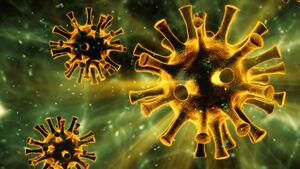Scientists are closely tracking mutations in the novel coronavirus, hoping that the virus evolves fast enough to give researchers hints about its future, but slow enough that the same researchers can make sense of, and keep up with, the changes.
The stakes couldn’t be higher. Efforts to contain the virus and treat the people it infects both hinge in part on the pathogen’s mutation rate.
So far, SARS-CoV-2 is cooperating. The virus is mutating at a rate, and with effects, that most experts consider normal. “I’ve not seen any evidence of mutations that should cause significant concern,” Oscar MacLean, a University of Glasgow bioinformatician, told The Daily Beast.
It might seem counterintuitive, but scientists worry as much about viruses that mutate slowly as they do viruses that mutate quickly. There’s a middle rate of change that researchers consider ideal for their efforts to develop therapies and recommend public health measures.
“If the pathogen evolves too slowly, we don’t have enough mutations to reconstruct the evolutionary history,” Niema Moshiri, a geneticist at the University of California, San Diego, told The Daily Beast. “If the pathogen evolves too rapidly, we have too many mutations, so the pathogen genomes look random [and] we’re unable to reconstruct the evolutionary history.”
“If the pathogen evolves just right, we have enough mutations to have evolutionary information, but not too many such that it becomes too much of a random mess—and we’re able to reconstruct the evolutionary history,” Moshiri said.
Scientists have lots of tools to track a pathogen’s mutations. They can draw viral genomes from the global GIS-AID database, analyze the genetic codes using tools such as CoV-GLUE, then visualize, in the form of phylogenetic maps, the genomes’ appearance across space and time.
Vaccine and drug developers prefer slow-changing viruses, of course. The more slowly a pathogen evolves, the less often developers have to tweak a vaccine or therapy to preserve its effectiveness, Moshiri explained.
But there’s also a public health benefit to a faster-changing virus. The more clear mutations that scientists can track over a short span of time, the more easily they can project likely future mutations, Moshiri said. Projections can help health officials decide when to impose bans, issue stay-at-home orders, close businesses, and deploy testing and medical resources.
In most cases, viruses mutate at rates that facilitate both sustainable drug development and effective public health measures. SARS-CoV-2 appears to occupy this middle ground. Despite some breathless reporting to the contrary, the novel coronavirus doesn’t seem to be mutating unusually fast or weirdly slowly.
All viruses mutate as they jump from person to person and community to community. After bouncing around China for a few weeks starting in December 2019, SARS-CoV-2 more or less simultaneously spread to Europe and other parts of East Asia. By early March, there were three fairly distinct major strains of the pathogen.
Separate SARS-CoV-2 strains leaped more or less directly from China to Los Angeles and Seattle in late January or early February. A few weeks later the virus traveled to New York City after a devastating stopover in Italy.
It’s this strain that has become “dominant” in Europe, Mexico, and the United States, according to Peter Forster, a Cambridge University geneticist who has mapped the virus’ spread. One controversial study by a team at Los Alamos National Laboratory in New Mexico claimed this dominant strain of SARS-CoV-2 is more infectious than other strains.
But many scientists questioned the New Mexico team’s conclusions. “I strongly caution against interpretation of selective effects in the global frequency,” tweeted Trevor Beford, a University of Washington epidemiologist.
The consensus is that the main Western strain of the novel coronavirus is no more dangerous than any other strain. Indeed, no version of the pathogen has proved more infectious or lethal than any other version. “Currently there is no epidemiological evidence of variation in the severity profile of SARS-CoV-2 infections between different locations,” Ben Cowling, a virologist at the University of Hong Kong, told The Daily Beast.
“We’ve separately been doing selection analyses to try and find signals of mutations that benefit the virus and have not been finding a huge amount at the moment,” MacLean said.
Nor are scientists seeing evidence that the novel coronavirus changes too slowly or too quickly for adequate study. The bad news is that SARS-CoV-2 is still spreading and still killing thousands of people every day.
The good news is that, so far, scientists are keeping up with it.






